case MSG_STARTED_GOING_TO_SLEEP:
/重点关注/
handleStartedGoingToSleep(msg.arg1);
break;
handleStartedGoingToSleep(msg.arg1);
protected void handleStartedGoingToSleep(int arg1) {
clearBiometricRecognized();
final int count = mCallbacks.size();
for (int i = 0; i < count; i++) {
KeyguardUpdateMonitorCallback cb = mCallbacks.get(i).get();
if (cb != null) {
cb.onStartedGoingToSleep(arg1);
}
}
mGoingToSleep = true;
/重点关注/
updateBiometricListeningState();//更新生物识别状态
}
updateBiometricListeningState()
//在这个方法中我们可以看到同时更新了指纹和人脸的状态
private void updateBiometricListeningState() {
updateFingerprintListeningState();
/重点关注/
updateFaceListeningState();
}
updateFaceListeningState()
private void updateFaceListeningState() {
// If this message exists, we should not authenticate again until this message is
// consumed by the handler
if (mHandler.hasMessages(MSG_BIOMETRIC_AUTHENTICATION_CONTINUE)) {
return;
}
mHandler.removeCallbacks(mRetryFaceAuthentication);
boolean shouldListenForFace = shouldListenForFace();
if (mFaceRunningState == BIOMETRIC_STATE_RUNNING && !shouldListenForFace) {
stopListeningForFace();
} else if (mFaceRunningState != BIOMETRIC_STATE_RUNNING
&& shouldListenForFace) {
/重点关注/
startListeningForFace();
}
}
startListeningForFace()
private void startListeningForFace() {
if (mFaceRunningState == BIOMETRIC_STATE_CANCELLING) {
setFaceRunningState(BIOMETRIC_STATE_CANCELLING_RESTARTING);
return;
}
if (DEBUG) Log.v(TAG, “startListeningForFace()”);
int userId = getCurrentUser();
if (isUnlockWithFacePossible(userId)) {
if (mFaceCancelSignal != null) {
mFaceCancelSignal.cancel();
}
mFaceCancelSignal = new CancellationSignal();
/重点关注/
mFaceManager.authenticate(null, mFaceCancelSignal, 0,
mFaceAuthenticationCallback, null, userId);
setFaceRunningState(BIOMETRIC_STATE_RUNNING);
}
}
frameworks/base/core/java/android/hardware/face/FaceManager.java
public void authenticate(@Nullable CryptoObject crypto, @Nullable CancellationSignal cancel,
int flags, @NonNull AuthenticationCallback callback, @Nullable Handler handler,
int userId) {
if (callback == null) {
throw new IllegalArgumentException(“Must supply an authentication callback”);
}
if (cancel != null) {
if (cancel.isCanceled()) {
Log.w(TAG, “authentication already canceled”);
return;
} else {
cancel.setOnCancelListener(new OnAuthenticationCancelListener(crypto));
}
}
if (mService != null) {
try {
useHandler(handler);
mAuthenticationCallback = callback;
mCryptoObject = crypto;
long sessionId = crypto != null ? crypto.getOpId() : 0;
Trace.beginSection(“FaceManager#authenticate”);
/重点关注/
mService.authenticate(mToken, sessionId, userId, mServiceReceiver,
flags, mContext.getOpPackageName());
} catch (RemoteException e) {
Log.w(TAG, "Remote exception while authenticating: ", e);
if (callback != null) {
// Though this may not be a hardware issue, it will cause apps to give up or
// try again later.
callback.onAuthenticationError(FACE_ERROR_HW_UNAVAILABLE,
getErrorString(mContext, FACE_ERROR_HW_UNAVAILABLE,
0 /* vendorCode */));
}
} finally {
Trace.endSection();
}
}
}
frameworks/base/services/core/java/com/android/server/biometrics/face/FaceService.java
@Override // Binder call
public void authenticate(final IBinder token, final long opId, int userId,
final IFaceServiceReceiver receiver, final int flags,
final String opPackageName) {
checkPermission(USE_BIOMETRIC_INTERNAL);
updateActiveGroup(userId, opPackageName);
final boolean restricted = isRestricted();
final AuthenticationClientImpl client = new FaceAuthClient(getContext(),
mDaemonWrapper, mHalDeviceId, token, new ServiceListenerImpl(receiver),
mCurrentUserId, 0 /* groupId */, opId, restricted, opPackageName,
0 /* cookie /, false / requireConfirmation */);
/重点关注/
authenticateInternal(client, opId, opPackageName);
}
frameworks/base/services/core/java/com/android/server/biometrics/BiometricServiceBase.java
protected void authenticateInternal(AuthenticationClientImpl client, long opId,
String opPackageName) {
final int callingUid = Binder.getCallingUid();
final int callingPid = Binder.getCallingPid();
final int callingUserId = UserHandle.getCallingUserId();
authenticateInternal(client, opId, opPackageName, callingUid, callingPid, callingUserId);
}
frameworks/base/services/core/java/com/android/server/biometrics/BiometricServiceBase.java
protected void authenticateInternal(AuthenticationClientImpl client, long opId,
String opPackageName, int callingUid, int callingPid, int callingUserId) {
if (!canUseBiometric(opPackageName, true /* foregroundOnly */, callingUid, callingPid,
callingUserId)) {
if (DEBUG) Slog.v(getTag(), "authenticate(): reject " + opPackageName);
return;
}
mHandler.post(() -> {
mMetricsLogger.histogram(getConstants().tagAuthToken(), opId != 0L ? 1 : 0);
// Get performance stats object for this user.
HashMap<Integer, PerformanceStats> pmap
= (opId == 0) ? mPerformanceMap : mCryptoPerformanceMap;
PerformanceStats stats = pmap.get(mCurrentUserId);
if (stats == null) {
stats = new PerformanceStats();
pmap.put(mCurrentUserId, stats);
}
mPerformanceStats = stats;
mIsCrypto = (opId != 0);
/重点关注/
startAuthentication(client, opPackageName);
});
}
startAuthentication(client, opPackageName);
private void startAuthentication(AuthenticationClientImpl client, String opPackageName) {
if (DEBUG) Slog.v(getTag(), “startAuthentication(” + opPackageName + “)”);
int lockoutMode = getLockoutMode();
if (lockoutMode != AuthenticationClient.LOCKOUT_NONE) {
Slog.v(getTag(), “In lockout mode(” + lockoutMode + “) ; disallowing authentication”);
int errorCode = lockoutMode == AuthenticationClient.LOCKOUT_TIMED ?
BiometricConstants.BIOMETRIC_ERROR_LOCKOUT :
BiometricConstants.BIOMETRIC_ERROR_LOCKOUT_PERMANENT;
if (!client.onError(getHalDeviceId(), errorCode, 0 /* vendorCode */)) {
Slog.w(getTag(), “Cannot send permanent lockout message to client”);
}
return;
}
/重点关注/
startClient(client, true /* initiatedByClient */);
//这里将AuthenticationClient传递进去
}
startClient(client, true /* initiatedByClient */);
private void startClient(ClientMonitor newClient, boolean initiatedByClient) {
ClientMonitor currentClient = mCurrentClient;
if (currentClient != null) {
if (DEBUG) Slog.v(getTag(), "request stop current client " +
currentClient.getOwnerString());
// This check only matters for FingerprintService, since enumerate may call back
// multiple times.
if (currentClient instanceof InternalEnumerateClient
|| currentClient instanceof InternalRemovalClient) {
// This condition means we’re currently running internal diagnostics to
// remove extra templates in the hardware and/or the software
// TODO: design an escape hatch in case client never finishes
if (newClient != null) {
Slog.w(getTag(), "Internal cleanup in progress but trying to start client "
-
newClient.getClass().getSuperclass().getSimpleName()
-
“(” + newClient.getOwnerString() + “)”
-
", initiatedByClient = " + initiatedByClient);
}
} else {
currentClient.stop(initiatedByClient);
// Only post the reset runnable for non-cleanup clients. Cleanup clients should
// never be forcibly stopped since they ensure synchronization between HAL and
// framework. Thus, we should instead just start the pending client once cleanup
// finishes instead of using the reset runnable.
mHandler.removeCallbacks(mResetClientState);
mHandler.postDelayed(mResetClientState, CANCEL_TIMEOUT_LIMIT);
}
mPendingClient = newClient;
} else if (newClient != null) {
// For BiometricPrompt clients, do not start until
// Service#startPreparedClient is called. BiometricService waits until all
// modalities are ready before initiating authentication.
if (newClient instanceof AuthenticationClient) {
AuthenticationClient client = (AuthenticationClient) newClient;
if (client.isBiometricPrompt()) {
if (DEBUG) Slog.v(getTag(), "Returning cookie: " + client.getCookie());
mCurrentClient = newClient;
if (mBiometricService == null) {
mBiometricService = IBiometricService.Stub.asInterface(
ServiceManager.getService(Context.BIOMETRIC_SERVICE));
}
try {
mBiometricService.onReadyForAuthentication(client.getCookie(),
client.getRequireConfirmation(), client.getTargetUserId());
} catch (RemoteException e) {
Slog.e(getTag(), “Remote exception”, e);
}
return;
}
}
// We are not a BiometricPrompt client, start the client immediately
mCurrentClient = newClient;
/重点关注/
startCurrentClient(mCurrentClient.getCookie());
//这里继续将AuthenticationClient传递进去
}
}
startCurrentClient(mCurrentClient.getCookie());
protected void startCurrentClient(int cookie) {
if (mCurrentClient == null) {
Slog.e(getTag(), “Trying to start null client!”);
return;
}
if (DEBUG) Slog.v(getTag(), "starting client "
-
mCurrentClient.getClass().getSuperclass().getSimpleName()
-
“(” + mCurrentClient.getOwnerString() + “)”
-
" cookie: " + cookie + “/” + mCurrentClient.getCookie());
if (cookie != mCurrentClient.getCookie()) {
Slog.e(getTag(), “Mismatched cookie”);
return;
}
notifyClientActiveCallbacks(true);
/重点关注/
mCurrentClient.start();
//这里调用的是AuthenticationClient的start方法
}
frameworks/base/services/core/java/com/android/server/biometrics/AuthenticationClient.java
public int start() {
mStarted = true;
onStart();
try {
/重点关注/
final int result = getDaemonWrapper().authenticate(mOpId, getGroupId());
if (result != 0) {
Slog.w(getLogTag(), “startAuthentication failed, result=” + result);
mMetricsLogger.histogram(mConstants.tagAuthStartError(), result);
onError(getHalDeviceId(), BiometricConstants.BIOMETRIC_ERROR_HW_UNAVAILABLE,
0 /* vendorCode */);
return result;
}
if (DEBUG) Slog.w(getLogTag(), “client " + getOwnerString() + " is authenticating…”);
} catch (RemoteException e) {
Slog.e(getLogTag(), “startAuthentication failed”, e);
return ERROR_ESRCH;
}
return 0; // success
}
start方法会调用faced,调用底层的人脸库,底层库返回结果后会调用onAuthenticated来反馈结果给receiver,在往上层反馈
五、人脸解锁屏幕
frameworks/base/services/core/java/com/android/server/biometrics/AuthenticationClient.java
public boolean onAuthenticated(BiometricAuthenticator.Identifier identifier,
boolean authenticated, ArrayList token) {
super.logOnAuthenticated(getContext(), authenticated, mRequireConfirmation,
getTargetUserId(), isBiometricPrompt());
final BiometricServiceBase.ServiceListener listener = getListener();
mMetricsLogger.action(mConstants.actionBiometricAuth(), authenticated);
boolean result = false;
try {
if (DEBUG) Slog.v(getLogTag(), “onAuthenticated(” + authenticated + “)”
-
“, ID:” + identifier.getBiometricId()
-
", Owner: " + getOwnerString()
-
", isBP: " + isBiometricPrompt()
-
", listener: " + listener
-
", requireConfirmation: " + mRequireConfirmation
-
", user: " + getTargetUserId());
if (authenticated) {
mAlreadyDone = true;
if (listener != null) {
vibrateSuccess();
}
result = true;
if (shouldFrameworkHandleLockout()) {
resetFailedAttempts();
}
onStop();
final byte[] byteToken = new byte[token.size()];
for (int i = 0; i < token.size(); i++) {
byteToken[i] = token.get(i);
}
if (isBiometricPrompt() && listener != null) {
// BiometricService will add the token to keystore
listener.onAuthenticationSucceededInternal(mRequireConfirmation, byteToken);
} else if (!isBiometricPrompt() && listener != null) {
KeyStore.getInstance().addAuthToken(byteToken);
try {
// Explicitly have if/else here to make it super obvious in case the code is
// touched in the future.
if (!getIsRestricted()) {
/重点关注/
listener.onAuthenticationSucceeded(
getHalDeviceId(), identifier, getTargetUserId());
} else {
listener.onAuthenticationSucceeded(
getHalDeviceId(), null, getTargetUserId());
}
} catch (RemoteException e) {
Slog.e(getLogTag(), “Remote exception”, e);
}
} else {
// Client not listening
Slog.w(getLogTag(), “Client not listening”);
result = true;
}
} else {
if (listener != null) {
vibrateError();
}
// Allow system-defined limit of number of attempts before giving up
final int lockoutMode = handleFailedAttempt();
if (lockoutMode != LOCKOUT_NONE && shouldFrameworkHandleLockout()) {
Slog.w(getLogTag(), “Forcing lockout (driver code should do this!), mode(”
- lockoutMode + “)”);
stop(false);
final int errorCode = lockoutMode == LOCKOUT_TIMED
-
? BiometricConstants.BIOMETRIC_ERROR_LOCKOUT
- BiometricConstants.BIOMETRIC_ERROR_LOCKOUT_PERMANENT;
onError(getHalDeviceId(), errorCode, 0 /* vendorCode */);
} else {
// Don’t send onAuthenticationFailed if we’re in lockout, it causes a
// janky UI on Keyguard/BiometricPrompt since “authentication failed”
// will show briefly and be replaced by “device locked out” message.
if (listener != null) {
if (isBiometricPrompt()) {
listener.onAuthenticationFailedInternal(getCookie(),
getRequireConfirmation());
} else {
listener.onAuthenticationFailed(getHalDeviceId());
}
}
}
result = lockoutMode != LOCKOUT_NONE; // in a lockout mode
}
} catch (RemoteException e) {
Slog.e(getLogTag(), “Remote exception”, e);
result = true;
}
return result;
}
frameworks/base/services/core/java/com/android/server/biometrics/BiometricServiceBase.java
protected interface ServiceListener {
default void onEnrollResult(BiometricAuthenticator.Identifier identifier,
int remaining) throws RemoteException {};
void onAcquired(long deviceId, int acquiredInfo, int vendorCode) throws RemoteException;
/重点关注/
default void onAuthenticationSucceeded(long deviceId,
BiometricAuthenticator.Identifier biometric, int userId) throws RemoteException {
throw new UnsupportedOperationException(“Stub!”);
}
default void onAuthenticationSucceededInternal(boolean requireConfirmation, byte[] token)
throws RemoteException {
throw new UnsupportedOperationException(“Stub!”);
}
default void onAuthenticationFailed(long deviceId) throws RemoteException {
throw new UnsupportedOperationException(“Stub!”);
}
default void onAuthenticationFailedInternal(int cookie, boolean requireConfirmation)
throws RemoteException {
throw new UnsupportedOperationException(“Stub!”);
}
void onError(long deviceId, int error, int vendorCode, int cookie) throws RemoteException;
default void onRemoved(BiometricAuthenticator.Identifier identifier,
int remaining) throws RemoteException {};
default void onEnumerated(BiometricAuthenticator.Identifier identifier,
int remaining) throws RemoteException {};
}
onAuthenticationSucceeded
/**
- Wraps the callback interface from Service -> BiometricPrompt
*/
protected abstract class BiometricServiceListener implements ServiceListener {
private IBiometricServiceReceiverInternal mWrapperReceiver;
public BiometricServiceListener(IBiometricServiceReceiverInternal wrapperReceiver) {
mWrapperReceiver = wrapperReceiver;
}
public IBiometricServiceReceiverInternal getWrapperReceiver() {
return mWrapperReceiver;
}
@Override
public void onAuthenticationSucceededInternal(boolean requireConfirmation, byte[] token)
throws RemoteException {
if (getWrapperReceiver() != null) {
/重点关注/
getWrapperReceiver().onAuthenticationSucceeded(requireConfirmation, token);
}
}
@Override
public void onAuthenticationFailedInternal(int cookie, boolean requireConfirmation)
throws RemoteException {
if (getWrapperReceiver() != null) {
getWrapperReceiver().onAuthenticationFailed(cookie, requireConfirmation);
}
}
}
frameworks/base/core/java/android/hardware/face/FaceManager.java
private IFaceServiceReceiver mServiceReceiver = new IFaceServiceReceiver.Stub() {
…
@Override // binder call
public void onAuthenticationSucceeded(long deviceId, Face face, int userId) {
/重点关注/
mHandler.obtainMessage(MSG_AUTHENTICATION_SUCCEEDED, userId, 0, face).sendToTarget();
}
MSG_AUTHENTICATION_SUCCEEDED
case MSG_AUTHENTICATION_SUCCEEDED:
/重点关注/
sendAuthenticatedSucceeded((Face) msg.obj, msg.arg1 /* userId */);
break;
sendAuthenticatedSucceeded
private void sendAuthenticatedSucceeded(Face face, int userId) {
if (mAuthenticationCallback != null) {
final AuthenticationResult result =
new AuthenticationResult(mCryptoObject, face, userId);
/重点关注/
mAuthenticationCallback.onAuthenticationSucceeded(result);
}
}
AuthenticationCallback是Fm的一个内部回调接口
public abstract static class AuthenticationCallback
extends BiometricAuthenticator.AuthenticationCallback {
/**
-
Called when an unrecoverable error has been encountered and the operation is complete.
-
No further callbacks will be made on this object.
-
@param errorCode An integer identifying the error message
-
@param errString A human-readable error string that can be shown in UI
*/
public void onAuthenticationError(int errorCode, CharSequence errString) {
}
/**
-
Called when a recoverable error has been encountered during authentication. The help
-
string is provided to give the user guidance for what went wrong, such as
-
“Sensor dirty, please clean it.”
-
@param helpCode An integer identifying the error message
-
@param helpString A human-readable string that can be shown in UI
*/
public void onAuthenticationHelp(int helpCode, CharSequence helpString) {
}
/**
-
Called when a face is recognized.
-
@param result An object containing authentication-related data
*/
/重点关注/
public void onAuthenticationSucceeded(AuthenticationResult result) {
}
/**
- Called when a face is detected but not recognized.
*/
public void onAuthenticationFailed() {
}
/**
-
Called when a face image has been acquired, but wasn’t processed yet.
-
@param acquireInfo one of FACE_ACQUIRED_* constants
-
@hide
*/
public void onAuthenticationAcquired(int acquireInfo) {
}
}
frameworks/base/packages/SystemUI/src/com/android/keyguard/KeyguardUpdateMonitor.java
AuthenticationCallback接口在KeyguardUpdateMonitor.java中实现,用于监听FaceService中人脸的解锁状态
@VisibleForTesting
FaceManager.AuthenticationCallback mFaceAuthenticationCallback
= new FaceManager.AuthenticationCallback() {
@Override
public void onAuthenticationFailed() {
handleFaceAuthFailed();
}
@Override
public void onAuthenticationSucceeded(FaceManager.AuthenticationResult result) {
Trace.beginSection(“KeyguardUpdateMonitor#onAuthenticationSucceeded”);
/重点关注/
handleFaceAuthenticated(result.getUserId());
Trace.endSection();
}
@Override
public void onAuthenticationHelp(int helpMsgId, CharSequence helpString) {
handleFaceHelp(helpMsgId, helpString.toString());
}
@Override
public void onAuthenticationError(int errMsgId, CharSequence errString) {
handleFaceError(errMsgId, errString.toString());
}
@Override
public void onAuthenticationAcquired(int acquireInfo) {
handleFaceAcquired(acquireInfo);
}
};
handleFaceAuthenticated
private void handleFaceAuthenticated(int authUserId) {
Trace.beginSection(“KeyGuardUpdateMonitor#handlerFaceAuthenticated”);
try {
final int userId;
try {
userId = ActivityManager.getService().getCurrentUser().id;
} catch (RemoteException e) {
Log.e(TAG, "Failed to get current user id: ", e);
return;
}
if (userId != authUserId) {
Log.d(TAG, "Face authenticated for wrong user: " + authUserId);
return;
}
if (isFaceDisabled(userId)) {
Log.d(TAG, "Face authentication disabled by DPM for userId: " + userId);
return;
}
/重点关注/
onFaceAuthenticated(userId);
} finally {
setFaceRunningState(BIOMETRIC_STATE_STOPPED);
}
Trace.endSection();
}
onFaceAuthenticated(userId)
protected void onFaceAuthenticated(int userId) {
Trace.beginSection(“KeyGuardUpdateMonitor#onFaceAuthenticated”);
mUserFaceAuthenticated.put(userId, true);
// Update/refresh trust state only if user can skip bouncer
if (getUserCanSkipBouncer(userId)) {
mTrustManager.unlockedByBiometricForUser(userId, BiometricSourceType.FACE);
}
// Don’t send cancel if authentication succeeds
mFaceCancelSignal = null;
for (int i = 0; i < mCallbacks.size(); i++) {
/重点关注/
KeyguardUpdateMonitorCallback cb = mCallbacks.get(i).get();
if (cb != null) {
/重点关注/
cb.onBiometricAuthenticated(userId,
BiometricSourceType.FACE);
}
}
mHandler.sendMessageDelayed(mHandler.obtainMessage(MSG_BIOMETRIC_AUTHENTICATION_CONTINUE),
BIOMETRIC_CONTINUE_DELAY_MS);
// Only authenticate face once when assistant is visible
mAssistantVisible = false;
Trace.endSection();
}
这里开始调用接口将解锁成功消息层层传递直至keyguard解锁,与指纹解锁逻辑一致
可以看到在onFaceAuthenticated(userId)方法中调用了KeyguardUpdateMonitorCallback这个抽象类的onBiometricAuthenticated()抽象方法,而BiometricUnlockController extends KeyguardUpdateMonitorCallback,并注册了回调mUpdateMonitor.registerCallback(this)
frameworks/base/packages/SystemUI/src/com/android/keyguard/KeyguardUpdateMonitorCallback.java
/**
-
Called when a biometric is recognized.
-
@param userId the user id for which the biometric sample was authenticated
-
@param biometricSourceType
*/
/重点关注/
public void onBiometricAuthenticated(int userId, BiometricSourceType biometricSourceType) { }
frameworks/base/packages/SystemUI/src/com/android/systemui/statusbar/phone/BiometricUnlockController.java
@Override
public void onBiometricAuthenticated(int userId, BiometricSourceType biometricSourceType) {
Trace.beginSection(“BiometricUnlockController#onBiometricAuthenticated”);
if (mUpdateMonitor.isGoingToSleep()) {
mPendingAuthenticatedUserId = userId;
mPendingAuthenticatedBioSourceType = biometricSourceType;
Trace.endSection();
return;
}
mMetricsLogger.write(new LogMaker(MetricsEvent.BIOMETRIC_AUTH)
.setType(MetricsEvent.TYPE_SUCCESS).setSubtype(toSubtype(biometricSourceType)));
/重点关注/
startWakeAndUnlock(calculateMode(biometricSourceType));
}
startWakeAndUnlock(calculateMode(biometricSourceType));
public void startWakeAndUnlock(int mode) {
// TODO(b/62444020): remove when this bug is fixed
Log.v(TAG, “startWakeAndUnlock(” + mode + “)”);
boolean wasDeviceInteractive = mUpdateMonitor.isDeviceInteractive();
mMode = mode;
mHasScreenTurnedOnSinceAuthenticating = false;
if (mMode == MODE_WAKE_AND_UNLOCK_PULSING && pulsingOrAod()) {
// If we are waking the device up while we are pulsing the clock and the
// notifications would light up first, creating an unpleasant animation.
// Defer changing the screen brightness by forcing doze brightness on our window
// until the clock and the notifications are faded out.
mStatusBarWindowController.setForceDozeBrightness(true);
}
// During wake and unlock, we need to draw black before waking up to avoid abrupt
// brightness changes due to display state transitions.
boolean alwaysOnEnabled = DozeParameters.getInstance(mContext).getAlwaysOn();
boolean delayWakeUp = mode == MODE_WAKE_AND_UNLOCK && alwaysOnEnabled && mWakeUpDelay > 0;
Runnable wakeUp = ()-> {
if (!wasDeviceInteractive) {
if (DEBUG_BIO_WAKELOCK) {
Log.i(TAG, “bio wakelock: Authenticated, waking up…”);
}
mPowerManager.wakeUp(SystemClock.uptimeMillis(), PowerManager.WAKE_REASON_GESTURE,
“android.policy:BIOMETRIC”);
}
if (delayWakeUp) {
/重点关注/
mKeyguardViewMediator.onWakeAndUnlocking();
}
Trace.beginSection(“release wake-and-unlock”);
releaseBiometricWakeLock();
Trace.endSection();
};
if (!delayWakeUp) {
wakeUp.run();
}
switch (mMode) {
case MODE_DISMISS_BOUNCER:
Trace.beginSection(“MODE_DISMISS”);
mStatusBarKeyguardViewManager.notifyKeyguardAuthenticated(
false /* strongAuth */);
Trace.endSection();
break;
case MODE_UNLOCK:
case MODE_SHOW_BOUNCER:
Trace.beginSection(“MODE_UNLOCK or MODE_SHOW_BOUNCER”);
if (!wasDeviceInteractive) {
mPendingShowBouncer = true;
} else {
showBouncer();
}
Trace.endSection();
break;
case MODE_WAKE_AND_UNLOCK_FROM_DREAM:
case MODE_WAKE_AND_UNLOCK_PULSING:
case MODE_WAKE_AND_UNLOCK:
if (mMode == MODE_WAKE_AND_UNLOCK_PULSING) {
Trace.beginSection(“MODE_WAKE_AND_UNLOCK_PULSING”);
mMediaManager.updateMediaMetaData(false /* metaDataChanged */,
true /* allowEnterAnimation */);
} else if (mMode == MODE_WAKE_AND_UNLOCK){
Trace.beginSection(“MODE_WAKE_AND_UNLOCK”);
} else {
Trace.beginSection(“MODE_WAKE_AND_UNLOCK_FROM_DREAM”);
mUpdateMonitor.awakenFromDream();
}
mStatusBarWindowController.setStatusBarFocusable(false);
if (delayWakeUp) {
mHandler.postDelayed(wakeUp, mWakeUpDelay);
} else {
mKeyguardViewMediator.onWakeAndUnlocking();
}
if (mStatusBar.getNavigationBarView() != null) {
mStatusBar.getNavigationBarView().setWakeAndUnlocking(true);
}
Trace.endSection();
break;
case MODE_ONLY_WAKE:
case MODE_NONE:
break;
}
mStatusBar.notifyBiometricAuthModeChanged();
Trace.endSection();
}
frameworks/base/packages/SystemUI/src/com/android/systemui/keyguard/KeyguardViewMediator.java
public void onWakeAndUnlocking() {
Trace.beginSection(“KeyguardViewMediator#onWakeAndUnlocking”);
mWakeAndUnlocking = true;
/重点关注/
keyguardDone();
Trace.endSection();
}
keyguardDone();
public void keyguardDone() {
Trace.beginSection(“KeyguardViewMediator#keyguardDone”);
if (DEBUG) Log.d(TAG, “keyguardDone()”);
userActivity();
EventLog.writeEvent(70000, 2);
/重点关注/
Message msg = mHandler.obtainMessage(KEYGUARD_DONE);
mHandler.sendMessage(msg);
Trace.endSection();
}
KEYGUARD_DONE
case KEYGUARD_DONE:
Trace.beginSection(“KeyguardViewMediator#handleMessage KEYGUARD_DONE”);
/重点关注/
handleKeyguardDone();
Trace.endSection();
break;
handleKeyguardDone();
private void handleKeyguardDone() {
Trace.beginSection(“KeyguardViewMediator#handleKeyguardDone”);
final int currentUser = KeyguardUpdateMonitor.getCurrentUser();
mUiOffloadThread.submit(() -> {
if (mLockPatternUtils.isSecure(currentUser)) {
mLockPatternUtils.getDevicePolicyManager().reportKeyguardDismissed(currentUser);
}
});
if (DEBUG) Log.d(TAG, “handleKeyguardDone”);
synchronized (this) {
resetKeyguardDonePendingLocked();
}
mUpdateMonitor.clearBiometricRecognized();
if (mGoingToSleep) {
Log.i(TAG, “Device is going to sleep, aborting keyguardDone”);
return;
}
if (mExitSecureCallback != null) {
try {
mExitSecureCallback.onKeyguardExitResult(true /* authenciated */);
} catch (RemoteException e) {
Slog.w(TAG, “Failed to call onKeyguardExitResult()”, e);
}
mExitSecureCallback = null;
// after succesfully exiting securely, no need to reshow
// the keyguard when they’ve released the lock
mExternallyEnabled = true;
mNeedToReshowWhenReenabled = false;
updateInputRestricted();
}
/重点关注/
handleHide();
Trace.endSection();
}
handleHide();
private void handleHide() {
Trace.beginSection(“KeyguardViewMediator#handleHide”);
// It’s possible that the device was unlocked in a dream state. It’s time to wake up.
if (mAodShowing) {
PowerManager pm = mContext.getSystemService(PowerManager.class);
pm.wakeUp(SystemClock.uptimeMillis(), PowerManager.WAKE_REASON_GESTURE,
“com.android.systemui:BOUNCER_DOZING”);
}
synchronized (KeyguardViewMediator.this) {
if (DEBUG) Log.d(TAG, “handleHide”);
if (mustNotUnlockCurrentUser()) {
// In split system user mode, we never unlock system user. The end user has to
// switch to another user.
// TODO: We should stop it early by disabling the swipe up flow. Right now swipe up
// still completes and makes the screen blank.
if (DEBUG) Log.d(TAG, “Split system user, quit unlocking.”);
return;
}
mHiding = true;
if (mShowing && !mOccluded) {
mKeyguardGoingAwayRunnable.run();
} else {
/重点关注/
handleStartKeyguardExitAnimation(
SystemClock.uptimeMillis() + mHideAnimation.getStartOffset(),
mHideAnimation.getDuration());
}
}
Trace.endSection();
}
handleHide();
private void handleHide() {
Trace.beginSection(“KeyguardViewMediator#handleHide”);
// It’s possible that the device was unlocked in a dream state. It’s time to wake up.
if (mAodShowing) {
PowerManager pm = mContext.getSystemService(PowerManager.class);
pm.wakeUp(SystemClock.uptimeMillis(), PowerManager.WAKE_REASON_GESTURE,
“com.android.systemui:BOUNCER_DOZING”);
}
synchronized (KeyguardViewMediator.this) {
if (DEBUG) Log.d(TAG, “handleHide”);
if (mustNotUnlockCurrentUser()) {
// In split system user mode, we never unlock system user. The end user has to
// switch to another user.
// TODO: We should stop it early by disabling the swipe up flow. Right now swipe up
// still completes and makes the screen blank.
if (DEBUG) Log.d(TAG, “Split system user, quit unlocking.”);
return;
}
mHiding = true;
if (mShowing && !mOccluded) {
mKeyguardGoingAwayRunnable.run();
} else {
/重点关注/
handleStartKeyguardExitAnimation(
SystemClock.uptimeMillis() + mHideAnimation.getStartOffset(),
mHideAnimation.getDuration());
}
}
Trace.endSection();
}
handleStartKeyguardExitAnimation
private void handleStartKeyguardExitAnimation(long startTime, long fadeoutDuration) {
Trace.beginSection(“KeyguardViewMediator#handleStartKeyguardExitAnimation”);
if (DEBUG) Log.d(TAG, “handleStartKeyguardExitAnimation startTime=” + startTime
自我介绍一下,小编13年上海交大毕业,曾经在小公司待过,也去过华为、OPPO等大厂,18年进入阿里一直到现在。
深知大多数Android工程师,想要提升技能,往往是自己摸索成长或者是报班学习,但对于培训机构动则几千的学费,着实压力不小。自己不成体系的自学效果低效又漫长,而且极易碰到天花板技术停滞不前!
因此收集整理了一份《2024年Android移动开发全套学习资料》,初衷也很简单,就是希望能够帮助到想自学提升又不知道该从何学起的朋友,同时减轻大家的负担。
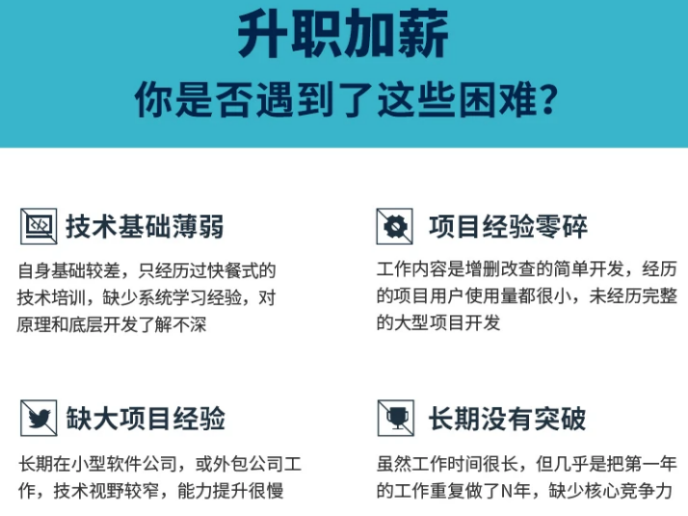

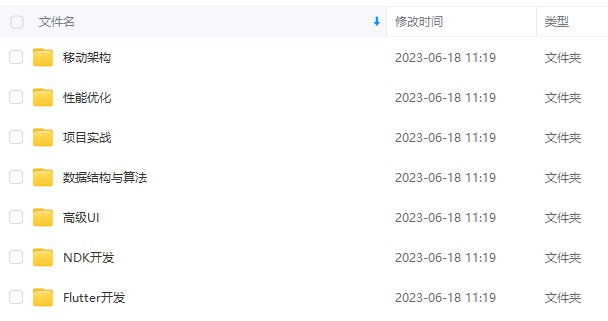

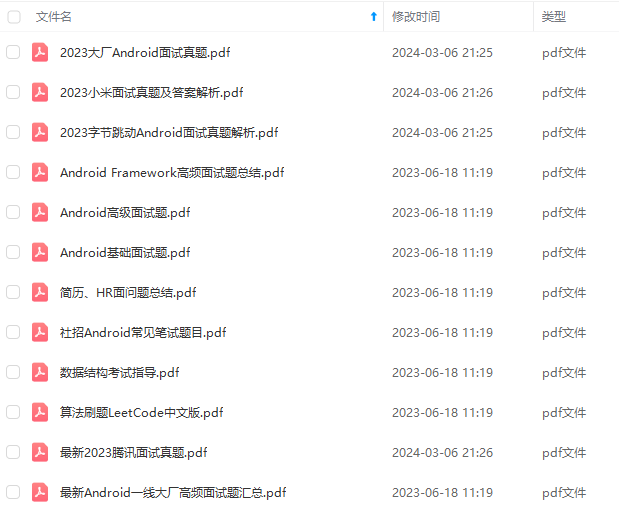
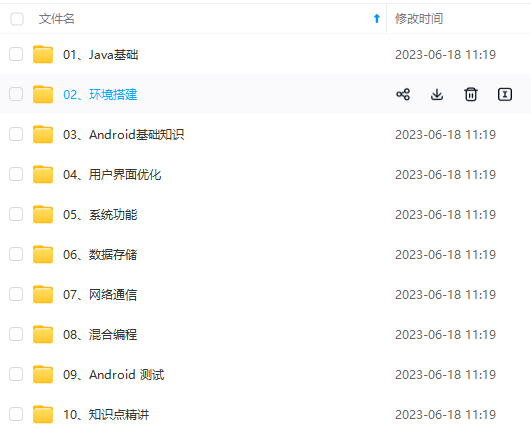
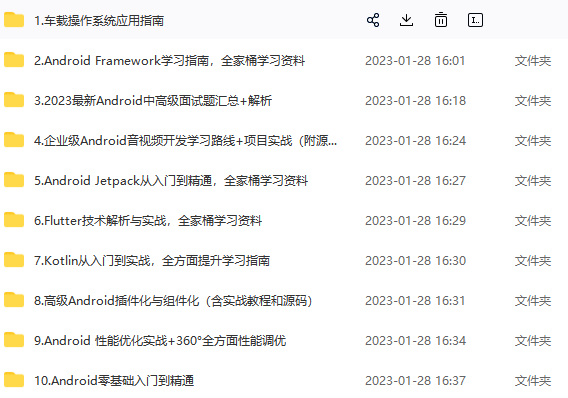
既有适合小白学习的零基础资料,也有适合3年以上经验的小伙伴深入学习提升的进阶课程,基本涵盖了95%以上Android开发知识点,真正体系化!
由于文件比较大,这里只是将部分目录大纲截图出来,每个节点里面都包含大厂面经、学习笔记、源码讲义、实战项目、讲解视频,并且后续会持续更新
如果你觉得这些内容对你有帮助,可以添加V获取:vip204888 (备注Android)

更多Android高级工程师进阶学习资料
进阶学习视频

附上:我们之前因为秋招收集的二十套一二线互联网公司Android面试真题(含BAT、小米、华为、美团、滴滴)和我自己整理Android复习笔记(包含Android基础知识点、Android扩展知识点、Android源码解析、设计模式汇总、Gradle知识点、常见算法题汇总。)

里面包含不同方向的自学编程路线、面试题集合/面经、及系列技术文章等,资源持续更新中…
一个人可以走的很快,但一群人才能走的更远。如果你从事以下工作或对以下感兴趣,欢迎戳这里加入程序员的圈子,让我们一起学习成长!
AI人工智能、Android移动开发、AIGC大模型、C C#、Go语言、Java、Linux运维、云计算、MySQL、PMP、网络安全、Python爬虫、UE5、UI设计、Unity3D、Web前端开发、产品经理、车载开发、大数据、鸿蒙、计算机网络、嵌入式物联网、软件测试、数据结构与算法、音视频开发、Flutter、IOS开发、PHP开发、.NET、安卓逆向、云计算
urn;
}
mHiding = true;
if (mShowing && !mOccluded) {
mKeyguardGoingAwayRunnable.run();
} else {
/重点关注/
handleStartKeyguardExitAnimation(
SystemClock.uptimeMillis() + mHideAnimation.getStartOffset(),
mHideAnimation.getDuration());
}
}
Trace.endSection();
}
handleStartKeyguardExitAnimation
private void handleStartKeyguardExitAnimation(long startTime, long fadeoutDuration) {
Trace.beginSection(“KeyguardViewMediator#handleStartKeyguardExitAnimation”);
if (DEBUG) Log.d(TAG, “handleStartKeyguardExitAnimation startTime=” + startTime
自我介绍一下,小编13年上海交大毕业,曾经在小公司待过,也去过华为、OPPO等大厂,18年进入阿里一直到现在。
深知大多数Android工程师,想要提升技能,往往是自己摸索成长或者是报班学习,但对于培训机构动则几千的学费,着实压力不小。自己不成体系的自学效果低效又漫长,而且极易碰到天花板技术停滞不前!
因此收集整理了一份《2024年Android移动开发全套学习资料》,初衷也很简单,就是希望能够帮助到想自学提升又不知道该从何学起的朋友,同时减轻大家的负担。
[外链图片转存中…(img-Ilhc4vyU-1712146053864)]
[外链图片转存中…(img-vywDtDd2-1712146053865)]
[外链图片转存中…(img-sUPzN0cX-1712146053865)]
[外链图片转存中…(img-UVcXd6Ru-1712146053866)]
[外链图片转存中…(img-GE2wCztk-1712146053866)]
[外链图片转存中…(img-jAYCOWgR-1712146053866)]

既有适合小白学习的零基础资料,也有适合3年以上经验的小伙伴深入学习提升的进阶课程,基本涵盖了95%以上Android开发知识点,真正体系化!
由于文件比较大,这里只是将部分目录大纲截图出来,每个节点里面都包含大厂面经、学习笔记、源码讲义、实战项目、讲解视频,并且后续会持续更新
如果你觉得这些内容对你有帮助,可以添加V获取:vip204888 (备注Android)
[外链图片转存中…(img-LjS7MEQm-1712146053867)]
更多Android高级工程师进阶学习资料
进阶学习视频
[外链图片转存中…(img-kLuQPpgA-1712146053867)]
附上:我们之前因为秋招收集的二十套一二线互联网公司Android面试真题(含BAT、小米、华为、美团、滴滴)和我自己整理Android复习笔记(包含Android基础知识点、Android扩展知识点、Android源码解析、设计模式汇总、Gradle知识点、常见算法题汇总。)
[外链图片转存中…(img-YPnoD8y6-1712146053867)]
里面包含不同方向的自学编程路线、面试题集合/面经、及系列技术文章等,资源持续更新中…
一个人可以走的很快,但一群人才能走的更远。如果你从事以下工作或对以下感兴趣,欢迎戳这里加入程序员的圈子,让我们一起学习成长!
AI人工智能、Android移动开发、AIGC大模型、C C#、Go语言、Java、Linux运维、云计算、MySQL、PMP、网络安全、Python爬虫、UE5、UI设计、Unity3D、Web前端开发、产品经理、车载开发、大数据、鸿蒙、计算机网络、嵌入式物联网、软件测试、数据结构与算法、音视频开发、Flutter、IOS开发、PHP开发、.NET、安卓逆向、云计算






















 2904
2904











 被折叠的 条评论
为什么被折叠?
被折叠的 条评论
为什么被折叠?








